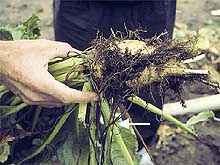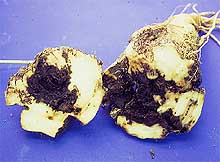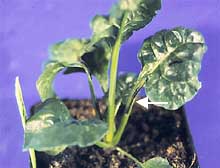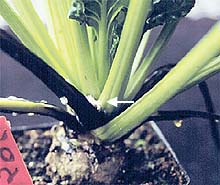|
First Report and
Virulence Evaluation of Erwinia carotovora subsp. betavasculorum
on Sugarbeet in Montana
Nina K. Zidack and Barry J. Jacobsen, Department of Plant
Science and Plant Pathology, Montana State University, Bozeman, MT 59717
Corresponding author: Barry J. Jacobsen.
uplbj@montana.edu
Abstract
Bacterial vascular necrosis of sugarbeet caused by Erwinia
carotovora subsp. betavasculorum (Ecb) was identified in the
Bighorn Valley near Hardin, Montana in 1998 and was observed at low
incidence in the Yellowstone River Valley in 1999 and 2000. Until now,
this disease had not been reported in Montana. Experiments were
performed comparing the Montana isolate with isolates of Ecb from
California for virulence against the California standards for sugarbeet
resistance to Ecb. In our experiments, the Montana isolate was more
virulent than all of the other isolates when plants were inoculated by
injecting Ecb into the petiole. Variety USH11 was the most resistant and
the most susceptible variety was Beta 4430, which has been shown to be
resistant to CA isolates in other tests. In temperature experiments,
sugarbeets became severely diseased at temperatures ranging from 20 to
28ºC, but severe beet (root) necrosis only developed at 24 and 28ºC.
Montana farmers and growers in northern sugarbeet-growing areas should
be aware of the potential for this disease during warm summers. Also, it
is clear from these results that the Montana isolate should be used to
screen varieties for resistance for Montana growers and that the
California isolates are not suitable for this purpose. Disease
management may be accomplished with resistant varieties, avoiding
injuries to plants, minimal rates of nitrogen fertilizer, early
planting, and plant spacings of 15 to 20 cm between plants (2).
Bacterial Vascular Necrosis
Bacterial vascular necrosis of sugarbeet was first reported in
California in 1972 (2) and has also been reported in Arizona, Idaho,
Texas and Washington. This disease caused by Erwinia carotovora
subsp. betavasculorum (Ecb) had never been reported in Montana.
In 1998, during a particularly warm summer, bacterial vascular necrosis
caused losses of 5 to 70% in individual fields in the Bighorn Valley
production area near Hardin, Montana (Barry Jacobsen, personal
observation). Damage was most severe where hail injury occurred. Ecb was
isolated from infected beets and its identity was confirmed using
nutritional assays (1).
Bacterial vascular necrosis of sugarbeet causes both
wilt and root rot symptoms in sugarbeet. Leaf symptoms (when present)
include black streaking of the petioles and froth in the centers of the
crowns, which is produced by escaping gasses produced by bacterial
fermentation. Root symptoms vary from soft rot to dry rot (4). The
disease is most severe at warm temperatures (24ºC and above) (3).
Disease symptoms on sugarbeets in the Bighorn Valley and on plants
artificially inoculated with the Montana isolate were consistent with
those described in the literature (Fig. 1).
|

A
|
|

B
|
|

C
|
|

D
|
|
(click
each image for a larger view)
Fig. 1. Symptoms of sugarbeet bacterial
vascular necrosis: (A) a field-grown sugarbeet showing
black rotted petioles and normal-appearing root exterior; (B)
cross section of a severely diseased sugarbeet; (C)
blackened petioles of a young sugarbeet plant inoculated with E.
caratovora subsp. betavasculorum; (D)
sugarbeet plant exhibiting severely blackened petioles and
bacterial fermentation froth in the crown area.
|
Because this is a new disease to Montana, the purpose of
this study was to determine similarity between the Montana isolate and
California isolates, and to determine if the host/pathogen interaction
is similar when inoculated onto standard susceptible and resistant
cultivars. Also, since this is mainly a pathogen in warmer production
regions, we wanted to test the Montana isolate for ability to cause
disease at lower temperatures as well as the warmer temperatures that
have been documented to promote severe disease in southern sugarbeet
growing areas.
Screening Sugarbeet Cultivars for Resistance to
Montana and California Isolates of Ecb
Five different sugarbeet cultivars (Table 1) were obtained from
Betaseed, Kimberly, ID. Seeds were germinated in Sunshine Mix (Sun Gro
Horticulture Inc., Bellevue, WA) and after emergence, transplanted into
a soil-mix consisting of equal parts of Bozeman silt loam soil, washed
concrete sand, and Canadian sphagnum peat moss, and grown for 4 weeks in
10 cm square pots. Glasshouse temperature was maintained at 22°C day/20°
night. The photoperiod was a minimum of 12 hours with M1000C/U lamps (Osram
Sylvania, Danvers, MA) used for supplemental lighting for two hours in
early morning and two hours in late afternoon during the winter. E.
carotovora subsp. betavasculorum isolates (Table 2) were
cultured on 50% tryptic soy agar for 2 days. Bacteria were harvested by
flooding the plates with sterile phosphate buffer (0.1M, pH 7.0).
Bacterial suspensions were then adjusted to OD (optical density) 1.0600nm
and diluted 10x to yield ~1 x
107 colony-forming units/ml (cfu/ml).
Table 1. Sugarbeet varieties with known resistance or
susceptibility to California isolates of Erwinia carotovora subsp.
betavasculorum (Ecb) obtained from Beta Seed, Kimberly, ID.
| Cultivar |
Resistance to Ecb |
Resistance to Other Diseases |
| USH11 |
Resistant |
None documented |
| Beta 4776R |
Resistant |
Rhizomania |
| Beta 4430R |
Resistant |
Rhizomania, Curly Top,
Fusarium Yellows |
| Beta 4035R |
Resistant |
Rhizomania, Curly Top |
| HH50 |
Susceptible |
None Documented |
Table 2. Erwinia carotovora subsp. betavasculorum
isolates used to inoculate five different varieties of sugarbeet.
| Isolate |
Source of Isolate |
| MT1 (MT)1 |
Hardin MT, 1998 |
| HS SP2 (CA) |
CA Department of Agriculture,
Dan Opgenorth |
| B3 (CA) |
US Department of Agriculture,
Beltsville, MD,
David Kuykendal |
| EC261 (CA) |
CA Department of Agriculture |
| HS SP5H (CA) |
CA Department of Agriculture |
1State of origin of Erwinia isolate.
For the Ecb isolate and sugarbeet variety tests, two
inoculation methods were used: 1) bacterial suspensions were injected
into petioles of the first two true leaves with a 26-gauge hypodermic
needle; and 2) 1 cm of leaf tips were sliced from the first two true
leaves with a scalpel that had been dipped into bacterial suspensions.
Plants were then transferred to a 28ºC growth chamber and rated for
disease development at 2 and 3 weeks post-inoculation using a 0 to 5
scale (0 = no disease, 1 = small black lesion, 2= wilted
petiole, 3 = systemic movement of pathogen evident as black streaking in
non-inoculated parts of plant, 4 = whole plant wilting, 5 = dead).
Testing the Temperature Requirements of the
Montana Isolate
Four different growth chambers were used for the temperature study
and were set at 16, 20, 24 and 28°C respectively. All had a light
period 14 hours at 850 foot candles (+/- 25). Two month-old plants were
inoculated by injecting 1 x 107
cells into 5 petioles approximately 2 cm from the crown. Plants were
evaluated 2 weeks later by measuring the length of the black lesion
which arose from the point of inoculation. Two months after treatment,
sugarbeet roots were removed from pots, sliced in half lengthwise, and
rated for percent necrosis of beet tissue.
Statistical analysis was performed using the General
Linear Models procedure of SAS (SAS Institute, Cary, NC). Least
significant differences (LSD’s) were calculated for the isolate/cultivar
test and orthogonal contrasts were performed for the temperature test.
All experiments were performed twice.
Disease Reaction of Five Sugarbeet Varieties to
the Montana and California Isolates of Ecb
Two weeks after inoculation, sugarbeets inoculated using the petiole
injection method showed more disease symptoms than plants treated using
the leaf slice inoculation method. All sugarbeet varieties inoculated
using the leaf slice inoculation method showed similar levels of disease
(Table 3). The petiole injection method yielded significant differences
between cultivars over all isolates tested. Beta 4430, a rhizomania-resistant
cultivar (Steve Kober, personal communication), was the most
susceptible. Variety USH11, the California standard for resistance
(Steve Kober, personal communication), was the most resistant, while the
standard susceptible variety HH50 was intermediate for disease in this
group of cultivars.
Table 3. Disease index of 5 varieties of sugarbeets
inoculated with Erwinia carotovora subsp. betavasculorum (Ecb)
averaged over 5 isolates of Ecb (2 weeks after inoculation).
| Variety |
Leaf
Inoculation |
Stem Injection |
| USH11 (R) |
1.37a1 |
1.55d |
| Beta 4776R (R) |
1.31a |
2.45b |
| Beta 4430R (R) |
1.29a |
2.92a |
| Beta 4035R (R) |
1.23a |
2.15bc |
| HH50 (S) |
1.31a |
2.01c |
| LSD0.05 |
0.36 |
0.38 |
1Within each column, means followed by the
same letter are not significantly different (P < 0.05).
The five Ecb isolates showed significant differences in
virulence with both inoculation methods, and the two methods yielded
different rankings for virulence of the isolates (Table 4). For the leaf
slice inoculation method, isolates HS SP2, B3, and EC261 had similar
levels of disease and were higher than MT1 and HS SP5H. The petiole
injection method resulted in the higher disease for the Montana isolate
(MT1), with the four other isolates similar when data was averaged
across all sugarbeet varieties. Statistical analysis revealed a highly
significant (P < 0.0001) interaction among sugarbeet variety and
isolate of Ecb (Table 5). The Montana isolate produced statistically
higher levels of disease for all varieties except Beta 4430R.
Table 4. Disease index of sugarbeet averaged over 5
varieties inoculated with 5 different isolates of Erwinia carotovora subsp.
betavasculorum using two different inoculation methods (2 weeks
after inoculation).
| Isolate |
Leaf
Inoculation |
Stem Injection |
| MT1 |
0.74b1 |
2.84a |
| HS SP2 |
1.74a |
2.13b |
| B3 |
1.56a |
2.11b |
| EC261 |
1.47a |
2.10b |
| HS SP5H |
1.00b |
1.89b |
| LSD0.05 |
0.31 |
0.40 |
1Within each column, means followed by the
same letter are not significantly different (P < 0.05).
Table 5. Disease index of 5 varieties of sugarbeet
inoculated with 5 different isolates of Erwinia carotovora subsp.
betavasculorum using the petiole injection method (2 weeks after
inoculation).
| Isolate |
Sugarbeet
Variety |
Isolate
LSD0.05 |
| HH50 |
Beta 4776 |
Beta 4430 |
Beta 4035 |
USH11 |
| MT1 |
2.58a1
(ab)2 |
2.78a
(ab) |
3.25a
(a) |
3.75a
(a) |
1.78a
(ab) |
(1.22) |
| B3 |
2.0ab
(b) |
2.2ab
(b) |
2.93a
(a) |
1.98b
(b) |
1.45ab
(c) |
(0.50) |
| EC 261 |
1.9b
(bc) |
2.37ab
(ab) |
2.9a
(a) |
1.6b
(c) |
1.73ab
(c) |
(0.57) |
| HS SP2 |
1.88b
(b) |
2.9a
(a) |
2.45a
(a) |
1.73b
(b) |
1.7ab
(b) |
(0.52) |
| HS SP5H |
1.68b
(bc) |
2.0b
(b) |
3.0a
(a) |
1.7b
(bc) |
1.08b
(c) |
(0.87) |
Variety
LSD0.05 |
0.58 |
0.76 |
1.16 |
0.62 |
0.67 |
|
1Within each column, means followed by the
same letter are not significantly different (P < 0.05).
2Within each row, means followed by the
same letter are not significantly different (P < 0.05).
Temperature Requirements of the Montana Isolate
Two weeks after sugarbeets were inoculated with Ecb isolate MT1
using the petiole injection method, the formation of black lesions up
and down the petiole had progressed rapidly for sugarbeets at 20, 24,
and 28ºC while plants held at 16ºC showed only small lesions.
Orthogonal contrasts indicated that plants at this temperature were
significantly less diseased than plants at all other temperatures (P
< 0.0001) (Table 6). Two months after inoculation, 60% of the plants
grown at 28ºC had died while only 10% had died at 24ºC and none had
died at 16 and 20ºC. Roots from plants grown at 28ºC were almost
completely rotted and beets at 24ºC also had significant damage. While
plants held at 20ºC had extensive lesion development, damage to root
tissue was minor and not significantly different than for sugarbeets
grown at 16ºC. Beets grown at 16 and 20ºC were significantly less
damaged than beets at 24 and 28ºC (P < 0.0001). These results for
the Montana isolate are consistent with published reports of temperature
requirements for disease development by California isolates (3). In
experiments not reported here, plants which showed very little disease
at 16ºC for over two weeks developed severe symptoms one to two days
after being transferred to 28ºC, and the majority were fully wilted
after approximately one week.
Table 6. Effect of post-inoculation temperature on
the development of lesion length (from site of inoculation), percent
taproot necrosis, and survival of plants inoculated with Ecb isolate MT.
| Temperature |
Lesion Length
(cm)1 |
Root Necrosis
(% necrotic area)2 |
% dead
8 wk AI |
| 16°C |
1.27 |
4.5 |
0 |
| 20°C |
7.16 |
4 |
0 |
| 24°C |
5.14 |
26.5 |
10 |
| 28°C |
6.77 |
75.5 |
60 |
1Black lesions were measured 2 weeks after
inoculation.
2Beet necrosis was measured as % necrosis of total beet root
tissue 2 months after inoculation.
Conclusions
These experiments show that the Montana isolate of Ecb is
significantly more virulent than the isolates from California against a
limited set of sugarbeet cultivars. Distribution in Montana seems to be
limited to the Bighorn and Yellowstone River valleys. In experiments not
reported here, 40% of sugarbeet varieties approved for the Billings
factory production area of Montana in 1999 and 2000 had high levels of
resistance. Reduced disease incidence in 1999 and 2000 is partially due
to growers in the affected area selecting resistant varieties or
avoiding highly susceptible varieties identified in our petiole
inoculation screening tests. We are continuing to screen approved
varieties and supply this information to growers and seed companies.
While this disease may not be a problem under normal growing conditions
in Montana, farmers should be aware of the potential for the development
of the disease during very warm summers or during warm periods following
hail storms. Montana growers should plant resistant varieties and may
also reduce disease potential by using minimal rates of nitrogen
fertilizer and maintaining in-row plant spacing of no more than 15-20 cm
(2). Disease severity has been reported to be higher under center pivot
irrigation as compared to furrow irrigation (4). This was true in the
1998 epiphytotic in the Bighorn river valley.
Acknowledgements
We would like to express our appreciation to Steve Kober (Betaseeds,
Inc.) for supplying sugarbeet seed and Dan Opgenorth (California
Department of Food and Agriculture) and David Kuykendal (USDA/ARS) for
providing isolates of Erwinia. This research was funded by the
Western Sugar Joint Grower Research Board and the Montana State
University Agricultural Experiment Station (MAES Project 913223). This
manuscript has been assigned Journal Series number 2001-13, Montana
Agricultural Experiment Station, Montana State University-Bozeman.
Literature Cited
1. Thomson, S. V., Hildebrand, D. C., and Schroth, M. N. 1981.
Identification and nutritional differentiation of the Erwinia sugar beet
pathogen from members of Erwinia carotovora and Erwinia
chrysanthemi. Phytopathology 71(10):1037-1042.
2. Thomson, S. V., Hills, F. J., Whitney, E. D., and
Schroth, M. N. 1980. Sugar and root yield of sugar beets as affected by
bacterial vascular necrosis and rot, nitrogen fertilization, and plant
spacing. Phytopathology 70: 605-608.
3. Thomson, S. V., Schroth, M. N., Hills, F. J., Whitney,
E. D., and Hildebrand, D. C. 1977. Bacterial vascular necrosis and rot
of sugarbeet: General description and etiology. Phytopathology
67:1183-1189.
4. Whitney, E. D. 1986. Diseases caused by bacteria and
bacterialike organisms. Pages 23-26 in: Compendium of Beet Diseases. E.
D. Whitney and James E. Duffus, eds. American Phytopathological Society,
St. Paul, MN. |



